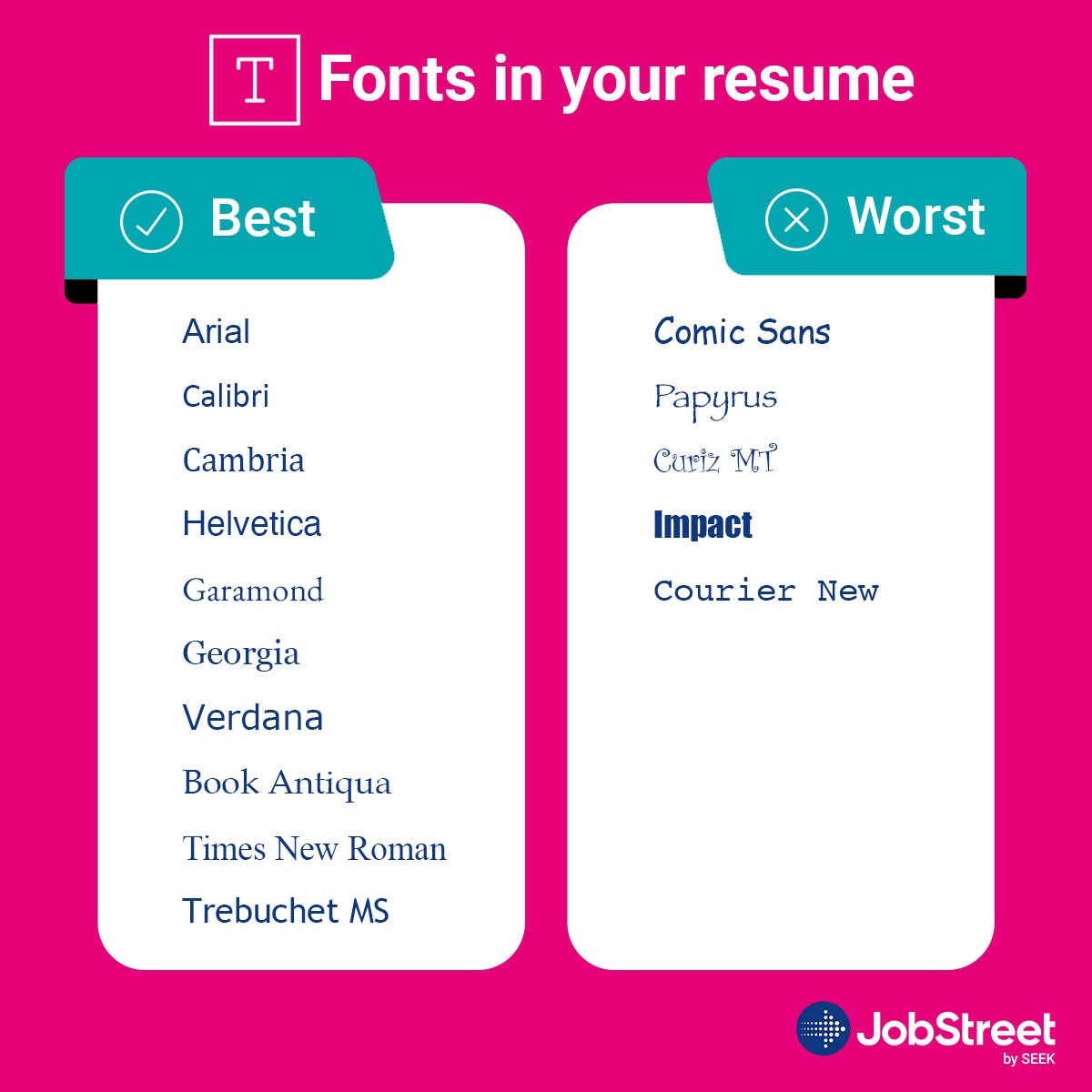Best resume fonts 2023: size, style & more
Introduction
Recruiters spend an average of 7.4 seconds looking at your resume before deciding whether you're suitable for the job. Within that short time, you'll want them to see your key qualifications and skills. Since your resume is one of the recruiter's first encounters with you, font makes a difference and sets the tone for your job application. You want to present yourself as a professional from the start.
Grabbing the hiring managers' attention begins with choosing the right fonts for your resume — one that's professional and readable. In this article, you'll find a list of foolproof fonts that job seekers like you can use in crafting resumes. We'll also explain the factors to consider when choosing the best resume fonts and give expert tips on using them.
- Understanding the basics of fonts
- Factors to consider when choosing a resume font
- Best font for resume
- Resume fonts to avoid
- Tips for using fonts in your resume
- Conclusion
- FAQs
Understanding the basics of fonts

Serif vs. sans serif fonts
There are two major families in the world of fonts: serif or sans serifs. The main difference between these font families is the presence or absence of tails, feet, tapers, or decorative lines within letters.
Serif fonts
These have tiny lines or dashes called “feet” attached to letters. One theory is that these feet were marks left by the brushes or quills used by scribes when they finished each stroke of a letter. Later on, the excess strokes evolved as an artful and decorative way of writing letters.
Serif fonts can have a historical, traditional, or vintage feel. You can see them in the logos of institutions that have existed for decades or centuries, like Dior, JPMorgan, or Rolex.
When you use serif fonts, you project a professional, authoritative look while suggesting you have considerable experience or a wealth of history behind you. Common examples of these fonts are Cambria, Garamond, and Times New Roman.
Sans serif fonts
These lack “feet” at the end of each letter. This type of font appeared in printed media around the 1800s. Sans serif fonts gained popularity because they were easy to read and used in displays and advertising. Brands like Meta, Google, Spotify, and Chanel use sans serif fonts.
Sans serif fonts are best used for resumes that are submitted digitally because they are easier to read on computers. They are simple, clean, and modern, making your own resume look up-to-date. Common sans serif fonts are Arial, Calibri, and Helvetica.
Different font families and their characteristics
There are currently five main font families. Aside from serif and sans serif, there are:
Monospace fonts
These use characters with the same width, giving them a clean and consistent feel. Monospace fonts are used to recreate vintage telegrams or typewritten letters. Examples include Consolas, Courier New, and Everson Mono.
Cursive fonts
These use letters with connective strokes, mimicking handwritten notes. They give a personalized touch to documents but are rarely used in professional settings. Examples of these are Adobe Poetica, Brush Script MT, and Magneto.
Fantasy fonts
These are non-cursive, stylized fonts with traditional alphabet glyphs. They are widely used in movie posters, signages, and other marketing materials. Examples of fantasy fonts are Alpha Geometrique, Cottonwood, and Critter.
Monospace, cursive, and fantasy fonts are harder to read, so they aren't commonly used for normal text and in resumes.
Font size and spacing
There are no hard rules when using font types, sizes, and spacing for resumes. However, keep in mind that smaller fonts make your resume hard to read, while large fonts may make your resume too long and tiring to read.
In general, the common sizes and spacing used vary depending on font, but the ideal font size for resumes would be between 10 to 12 points for normal text, with 1 or 1.15 line spacing between text. This range makes your resume readable while efficiently fitting all the information into a page or two. A resume spanning two pages should be avoided.
Your name should have the largest font size in the resume, usually between 18 to 25 points, to make it easier for the recruiter to see your name at a glance. The headings, on the other hand, can be around 14 to 16 points. They must be slightly larger than the body section text so the recruiter can easily spot the relevant sections of your resume.
You may adjust the font size and spacing according to your chosen font as you want your resume to be readable and pleasing to the recruiter.
Factors to consider when choosing a resume font

When choosing a good font for your resume, consider the following factors:
- Your industry and job type.Are you applying for a job in a creative industry, like graphic design, or for a creative role, such as an art director? If so, you can be more creative in selecting your font and go for the less common font styles.
- Your personal brand and style.If your personal brand is authoritative, or you are an expert in your field, consider using serif fonts since these can reflect a more traditional look. If your style is more modern and you are a new graduate, consider a sans serif font instead.
- Legibilityrefers to the reader's ease of distinguishing one letter from another and depends on a font's design. Font legibility helps people identify words easily and faster, which leads to better understanding.
- Readabilityis about how a font is arranged and depends on its size, spacing, and other formatting on the page. Readability is important because your goal is to make the recruiter process all the information you placed in your resume.
- Applicant tracking system (ATS). Since HR departments receive hundreds of applications, they use an ATS to filter them. That's why you'll need to use an ATS-compatible font. Here's how it works: After you submit an online application, the ATS receives it and scans your resume. It then pulls out relevant information to create a digital candidate profile. From these profiles, recruiters search for keywords in the ATS, generating a list of resumes that best match the keywords.
Use an ATS-compatible font so the system won't miss any important information when creating your candidate profile. If your font isn't ATS compatible, the system won't be able to read your resume and might end up placing gibberish words in your profile. ATS-compliant fonts that you can use in your resume include:
For serif fonts:
- Cambria
- Garamond
- Georgia
- Palatino
- Times New Roman
For sans serif fonts:
- Arial
- Calibri
- Helvetica
- Tahoma
- Verdana
Best font for resume

Here are the most professional font types for the best resume to make sure that recruiters see your potential:
- Arialis a sans serif font with a simple, neat, and straightforward look. This is a go to font for your resume because of its readability, legibility, and ATS compatibility. An alternative is Arial Narrow.
- Calibriis theMicrosoft Word default font. It is simple, easy to read, and saves space.
- Cambriais a serif font specifically crafted to read on computer monitors. It has sturdy letter construction that is great for online and print reading.
- Helveticahas been dubbed one of the most elegant and modern sans serif fonts. Its modern, clean look can give your resume a professional and contemporary look.
- Garamondis a classic and clear font that gives your resume a polished look. This font is highly legible, so you can use this if you're trying to fit information into one page without sacrificing the overall readability of your resume.
- Georgiais one of the popular fonts that looks like the wider and thicker version of Times New Roman, making it easier to read even if you use small font sizes. Since this type is designed to be read on computer monitors, it's best used if you're sending digital versions of your resume.
- Verdanais a sans serif font designed to be read in small print and on computer screens. It's one of the most professional fonts for resumes, especially for job seekers who want to squeeze more information on the page without sacrificing legibility.
- Book Antiquais a great font if you want a classy touch to your resume, as it is based on Old English calligraphy. This font style is usually used for headings rather than normal text.
- Times New Romanis one of the most classic fonts in the world. It's classic, timeless, traditional, and easily recognizable.
- Trebuchet MSis a thick and rounded sans serif font. It takes up more space, making it a practical choice for entry-level job seekers who want to fill up a page
Resume fonts to avoid
An important career advice: not all fonts are meant to be used for resumes. Particular font types that are heavily stylized, cursive, or have bubble letters are some of the worst resume fonts that are hard to read and not compatible with Applicant Tracking Systems (ATS) programs. These are some other fonts that you should avoid using in your resumes:
- Comic Sans
- Papyrus
- Curlz MT
- Impact
- Courier New
Tips for using fonts in your resume
Consistency in font choice
Using consistent and clean fonts in your resume gives it a professional and coherent look for your hiring manager. It also ensures that the content will be easy to follow and understand. Inconsistent font choices or font size, such as using two fonts that are very different from each other, and using more than two fonts, can make your resume look jarring and can be hard to read. Your potential employer might overlook resumes with fonts that are too contrasting, so the safest thing to do is to draft a clean, simple, and font-consistent resume where your information is clear and legible right away.
Using proper font formatting
There are many ways to liven up the fonts in your resume for resume readability but do so in moderation. Bold text is great if you want to draw attention to important words. You can use this to emphasize a few words without increasing their size. Italics, on the other hand, are useful when you want to subtly emphasize supporting text. For instance, you can italicize places related to your university degree.
Although there are many ways to emphasize words, avoid placing words in all caps and underlining words. Using all caps for words instead of lowercase letters can make the reader feel like you are shouting at them while underlining words or phrases can make your resume look cluttered.
Incorporating color in your resume
You can use color to direct attention to important parts of your resume or show creativity and style. You can add color to your name, headings, or specific sections. Use complementary colors in your headings to make it easier for the recruiter to quickly find key information in your resume. The type of industry you're applying for in your job search is an important consideration when using color in your resume. Research the culture of the company you are applying to first.
If the job seems to have a creative and modern culture, you can use bright and lively colors to stand out from other job seekers. Colorful resumes are also great for those applying as a graphic artist, interior designer, marketing associate, or other creative jobs.
It's safer to use black or dark colors, like navy blue, if the company you are applying to in your job search is formal and traditional, such as a law firm or a finance company. Make your life easier by using a plain black-and-white resume when applying online, as adding different colors might confuse an ATS or other application scanning software, preventing them from accurately creating your candidate profile.
Since digital resumes are viewed on different devices, the colors, fonts, and other designs you use on your resume might be altered, making your resume illegible and difficult to read. You can test out your resume on various devices before sending it off.
Conclusion
Ultimately, the key takeaway is that your qualifications, skills, and experiences are what recruiters look at during a job search. But the way you present yourself through your resume is also important. Your resume gives recruiters their first impression of you and boosts your chances of getting noticed. That's why it's important to understand the basics of using fonts, the different factors to consider when choosing the right font for your resume, and the fonts to use and avoid.
When you choose a good font for your resume, you increase the chances of catching the attention of recruiters and ensure that they continue reading your resume for over 7 seconds.
FAQs
Can I use more than one font style in my resume body?
Yes, you can. There is no limit to the number of fonts you can use in your resume but we highly recommend using one font style only for a clean, professional look. You can use two font styles in your resume, one for the headings and one for the body text, but do so sparingly.
Should I use a different font for my name and contact information?
You can use a default font for your name if you want it to stand out but make sure the second font for your contact information is the same as the font for the body text on your resume. This is to maintain your resume's readability.
Can I use a decorative font for my resume?
Decorative fonts like Comic Sans are not common in resumes unless you apply for a creative position. Generally, resumes with professional and easy-to-read fonts have higher chances of being considered by recruiters.
How do I know if my font choice is ATS-friendly?
As long as you use sans serif or serif fonts, ATS algorithms can recognize them. See the ATS-friendly fonts we listed above in the article.
Is it okay to use a font that is not commonly used in resumes?
Uncommon fonts can be used in resumes as long as they are readable, legible, and ATS-friendly. If you are applying in a creative industry or advertising industry, an uncommon font type could help set you apart from other job seekers.
Have you picked the best resume fonts? Now you can send it out as you #SEEKBetter jobs. Find the right job for you by creating your Jobstreet profile. Download the Jobstreet app on Google Play or App Store to quickly send out your carefully-crafted professional resumes.
Check out our Career Advice for more expert tips on your professional journey.
